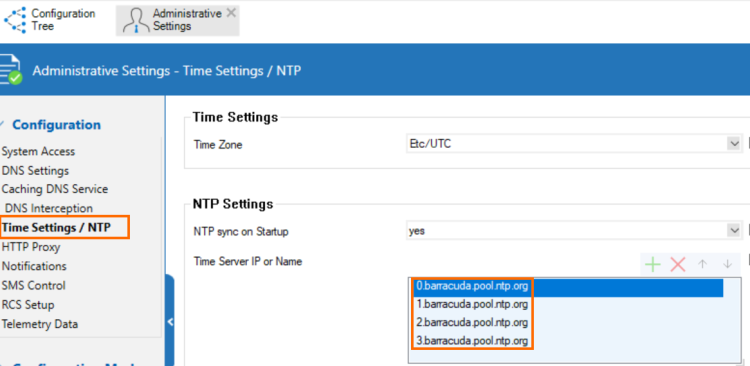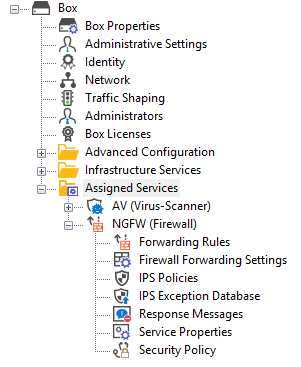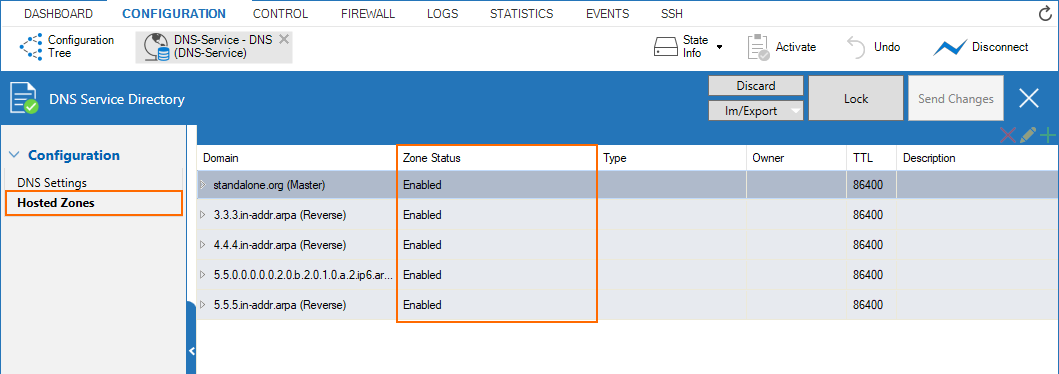Migrating the Old 3-Layer Server-Service Architecture to the New 2-Layer Assigned Services Architecture
With firmware version 8.0.6, you have the option to migrate the former 3-layer server-service architecture to the new 2-layer Assigned Services architecture. Although this is optional in all 8.0.x releases, it will be mandatory in the next upcoming major release.
AutoVPN
For Barracuda-only environments, setting up a site-to-site VPN tunnel has been greatly improved. The new AutoVPN feature provides robust VPN connections through TINA tunnels that are automatically set up with dynamic routing between local networks. AutoVPN is suited for creating multiple boxes in the cloud and connecting them with a TINA site-to-site VPN tunnel.
The automatic setup of VPN tunnels is initiated via the command-line interface (CLI) and REST API.
For more information, see AutoVPN for CloudGen Firewall Devices 8.0.1 or Higher.
Barracuda Control Center License Activation
When a Control Center is started for the first time, the CC Wizard will prompt you to enter a username and a password that will be used to automatically download licenses.
For more information, see Getting Started - Control Center.
Barracuda Firewall Insights
The Barracuda Reporting Server has been replaced by Barracuda Firewall Insights. Barracuda Firewall Insights is an advanced reporting and analytics platform that ingests, aggregates, and analyzes data automatically from any CloudGen Firewall deployed across your organizational network, including public cloud deployments. Analytics by Firewall Insights provide actionable information for the entire WAN, including dynamic availability information on SD-WAN connections, transport data, security, and web and network traffic details.
For more information, see Firewall Insights.
Control Centers Operating in a Parent-to-Child Relation
In the past, the configuration of Control Centers operating in a parent-to-child relation required modifying the host firewall rule set of the firewall. As of release 8.0.6, this is no longer necessary. Firmware release 8.0.6 now covers all necessary steps that require the user to perform a minimum of configuration steps to set up split Control Centers without having to modify the host firewall rule set.
In case you are already running split Control Centers, some steps must be performed before upgrading to firmware 8.0.6.
For more information, see 8.0.6 Migration Notes and its subordinated migration articles that relate to your running firmware versions, specifically the paragraph Important Notes Before Migrating.
Custom Box Descriptors
When managing a large number of firewalls in the Control Center, the naming scheme of the CloudGen Firewall proved to be insufficient. The Control Center now has an additional functionality to extend the standard naming scheme for CloudGen Firewalls. This functionality includes the option to enter additional fields for a more distinctive naming scheme of managed CloudGen Firewalls.
For more information, see How to Configure Custom Box Descriptors and Filter Managed Firewalls in Different Data Views.
Disk Encryption
To achieve higher protection for your data on your firewall, you can encrypt the hard disk. To do so, you must set a parameter in the corresponding configuration window of NGInstall and then re-install your firewall from scratch.
For more information, see How to Deploy a CloudGen Firewall Vx using Firewall Install on a VMware Hypervisor.
To download the newest version of NGInstall that includes the updates, go to https://dlportal.barracudanetworks.com/#/packages/5238/NGInstall_8.0.5-10.exe.
KTINA FIPS Crypto Module
FIPS 140-2 revalidation with Barracuda KTINA FIPS Crypto Module is in progress.
For more information, see https://csrc.nist.gov/Projects/cryptographic-module-validation-program/modules-in-process/Modules-In-Process-List.
Along with the Barracuda Cryptographic Software Module, the VPN server will be FIPS 140-2 compliant again.
For more information, see https://csrc.nist.gov/projects/cryptographic-module-validation-program/certificate/2458.
IPv6 for Client-to-Site Payload
Client-to-Site VPN TINA tunnels now support the configuration of IPv6 client networks.
Microsoft Azure Market Place Improvements
The Microsoft Azure Marketplace supports the deployment of High Availability clusters. High Availability ensures that the services running on the CloudGen Firewall are always available even if one unit is unavailable. It is therefore highly recommended. The deployment of a CloudGen Firewall in Microsoft Azure is easy thanks to the web interface that guides you through the process.
Microsoft Azure Virtual WAN
The Barracuda CloudGen Firewall supports up to four Internet Service Provider (ISP) links to Microsoft Azure Virtual WAN. You must have a static IPv4 public IP address with similar bandwidth and latency. For each link, two active-active IPsec IKEv2 VPN tunnels are automatically created if you use automated connectivity. BGP multipath routing is used to route the traffic, and the configuration of BGP multipath routing is likewise set up automatically when using automated connectivity. The firewall learns path information as set by the Virtual WAN hub, which results in better path affinity. In addition, BGP-based load balancing and automatic path failover are used for the best connection results.
For more information, see Azure Virtual WAN.
Multi-Factor Authentication with Time-Based One-Time Password (TOTP)
With the release of firmware version 8.0.1, the Barracuda CloudGen Firewall supports multi-factor authentication for user accounts on an individual basis, using a time-based one-time password (TOTP) as a secondary authentication method. Multi-factor authentication can be enabled for client-to-site VPN (TINA protocol only), SSL VPN, CudaLaunch, and the Barracuda VPN Client for Windows. Multi-factor authentication using TOTP requires an Advanced Remote Access subscription.
For more information, see How to Configure Multi-Factor Authentication Using Time-based One-time Password (TOTP).
NTP Servers for the Barracuda Zones
The NTP default configuration now displays 4 NTP servers for the Barracuda zone in CONFIGURATION > Configuration Tree > Box > Administrative Settings.

New DNS User Interface and Advanced DNS Features
The DNS service has been refactored and now offers a new user interface. This user interface is now tightly incorporated into new features that extend the DNS by various advanced options. The feature set of the new DNS service now includes:
- Stand-alone and distributed DNS service
- Primary / Secondary / Forward DNS zones
- Split DNS
- Health probing
Replacement of Virtual Servers by a New 2-Layer Architecture
The former 3-layer server-service architecture has been replaced by a 2-layer architecture in which services are now operated on top of the box layer. With firmware 8.0.1, services are subordinated to the Assigned Services node and allow a simpler administration of services and reduce error-prone issues by limiting services to run only on the box they are initially created on.

For more information, see Assigned Services and Understanding Assigned Services.
Optimized Command-Line Tool for Configuring an HA Pair of Firewalls in the Cloud
The command-line tool create-dha for creating an HA pair of firewalls in the cloud has been optimized. The command no longer requires you to configure the parameter of a netmask because both firewalls must be configured in a subnet of the same size.
REST API Extensions
- REST calls for logins, logout, and authentication for endpoints
- REST for all common access rule operations: create / delete / list / change
- REST calls for network objects (stand-alone + CC (global cluster firewall objects))
- REST calls for service objects (CC + stand-alone)
- REST calls for enabling and activating IPS
- REST calls to allow you to manage box administrators
- REST calls to allow you to manage tokens
- CLI tool to enable REST by default on cloud firewalls (place in user data)
For more information, see https://campus.barracuda.com/product/cloudgenfirewall/api/8.0
SNMP
SNMP now provides the option to monitor license status, the number of days until a license expires, and the current number of protected IPs.
Also, there is now the option to monitor certificates and their expiration date.
SSL VPN
The new TOTP portal provides self-enrollment and self-service of the TOTP authentication scheme.
SSL VPN resources can now be configured as dynamic apps. If configured as a dynamic app, Super Users can enable, disable, or time-enable a resource. Dynamic access can be configured for web apps, native apps, generic tunnels, and network places.
For more information, see SSL VPN.
Usage of DHCP on a VLAN Interface
Requesting an IP address from a DHCP server for a VLAN interface is supported by a feature called Header Reordering and can be found in the VLANs Window accessible in CONFIGURATION > Configuration Tree > Network > Virtual LANs.
For correct usage of the user interface item Header Reordering, see the following table:
| User Action | User Interface Item | Description |
|---|---|---|
| Default state: header reordering is off. |  | No header reordering is done for DHCP on a VLAN interface. |
| Select the check box in case the assignment of an IP address from a DHCP server fails. |  | Header reordering for DHCP on a VLAN interface is now activated. |
VPN IPv6 Payloads
With the exception of SD-WAN, IPv6 payloads in VPN tunnels are supported and now work for TINA site-to-site and client-to-site tunnels.
What's New in Version 8.0.6
A filter and search function has been added to the list view for routing tables in CONTROL > Network.

See the next section for further improvements included in version 8.0.6.
Improvements Included in Version 8.0.6
Appliances
- The LCD now works as expected on the F1000B. [BNNGF-83659]
Authentication
- SAML authentication metadata is now generated correctly for a managed box. [BNNGF-76521]
- RADIUS no longer gets spammed with authentication requests when C2S/NAC has UDP chosen as transport. [BNNGF-80365]
Barracuda Firewall Admin
- IP addresses can now be filtered for the display of routing tables at CONTROL > Network, table Routing Tables. [BNNGF-55577]
- Creating certificates in Firewall Admin now forces the key length to be a multiple of 8 characters and ensures the creation process to succeed. [BNNGF-65515]
- The UI option for importing a certificate has been consolidated and is now displayed with the text Import Certificate from File… at its current places in the UI. [BNNGF-76877]
- On a Control Center it is possible to enter pattern-based entries for cluster links in ADMINS > my admin > Administrator Scopes > Global linked >Administrative Scope > Links. [BNNGF-76899]
- Creating certificates with PCs located in the US no longer causes issues. [BNNGF-76958]
- When creating a certificate, it is now possible to enter an asterisk character (*) into the CF field. [BNNGF-78483]
- Pasting data from the clipboard into txt record now works as expected. [BNNGF-78797]
- When switching from the FIREWALL > Forwarding Rules tab to the Firewall > local tab, the Refresh button no longer vanishes. [BNNGF-79937]
Barracuda OS
- The default behavior for WWAN-capable CGF boxes with an attached M40/M41 modem is now set to perform SIM autoconfiguration. [BNNGF-69443]
- Connecting to a box via GUI no longer fails in certain situations. [BNNGF-70271]
- Firewalls running in an HA cluster now also support pool licenses even if there is only one license in the pool available. [BNNGF-70645]
- Importing a PEM file now writes the certificate chain correctly to the related configuration file. [BNNGF-70649]
- The boot status LED now works as expected. [BNNGF-71629]
- The Control Center no longer crashes in certain situations after reporting the error message "skb_warn_bad_offload". [BNNGF-73804]
- Default routes are now provided to DHCP clients as expected. [BNNGF-75691]
- Event notification now works as expected. [BNNGF-76327]
- Filebeat clients now report through the management tunnel as expected. [BNNGF-78034]
- Two boxes as part of an HA pair no longer crash simultaneously in certain situations. [BNNGF-78380]
- The
cstatdlog files no longer get flooded and thephion0partition no longer runs out of space. [BNNGF-78865] - Outdated Let's Encrypt certificates no longer cause problems in certain situations. [BNNGF-79158]
- After moving the FTP plugin into the kernel space, a pair of HA firewalls no longer crashes in certain situations. [BNNGF-80493]
- The firewall no longer freezes in certain situations. [BNNGF-80576]
Control Center
- Discontinued/outdated licenses are ignored when a valid license subscription is activated in the Control Center. [BNNGF-71216]
- Pool licenses can now also be removed during an update of other pool licenses. [BNNGF-72989]
- If the auto-reassignment of an updated pool license to the managed firewalls fails at the first attempt, it will be retried. [BNNGF-73301]
- The CC clone wizard now adds the correct name to the new target box. [BNNGF-76336]
- On a Control Center, it is possible to enter pattern-based entries for cluster links in ADMINS > my admin > Administrator Scopes > Global linked > Administrative Scope > Links. [BNNGF-76870]
- Box descriptor fields now accept strings with a maximum length of 100 characters. [BNNGF-78146]
- Repository nodes can now contain the '-' character. [BNNGF-78196]
- A bug has been fixed where locking the FSC editor in Cluster Settings caused the FSC communication daemon to crash. [BNNGF-79090]
DHCP
- After a firmware update, DHCP now starts up as expected. [BNNGF-78040]
DNS
- The option to enter the forward source-ip for outgoing DNS queries has been added to the DNS settings. [BNNGF-71995]
- The BIND system has been updated to version 9.16.x. [BNNGF-74788]
Firewall
- The categorization of URLs for URL filters now works as expected. [BNNGF-78381]
HTTP Proxy
- URL filter categories now work as expected in the settings for the HTTP proxy access control.
See also the red note in the article [https://campus.barracuda.com/product/cloudgenfirewall/doc/96768141/migration-from-8-0-1-8-0-2-8-0-3-8-0-4-8-0-5-to-8-0-6/] . [BNNGF-74895]
NGInstall
- NGInstall now provides the option to activate disk encryption. [BNNGF-76887]
REST
- The REST API call for determining the usage of memory now considers disk space usage in a dedicated diskState field. [BNNGF-76335]
SSL-VPN
- RDP connections no longer crash under high loads. [BNNGS-3761]
- OpenSSL no longer experiences infinite loops when parsing certificates. [BNNGF-83054]
- HTTP connections are cleaned up as expected. [BNNGS-3894]
- SSL VPN now provides information for "VPN profile OTP" to CudaLaunch. [BNNGS-3896]
- Clean-ups of VPN SSL sessions now work as expected and Firewall Admin no longer displays empty sessions in the VPN tab under Client-to-Site. [BNNGS-3897]
- Uncompleted connection attempts to SSL VPN no longer occur in certain situations. [BNNGS-3913]
- Web apps now open as expected for SSL VPN after an update to firmware version 8.2.1. [BNNGS-3917]
- If a tunnel's forwarding partner temporarily goes down, traffic is no longer blocked. [BNNGS-3920]
- Clean-up of orphaned sessions no longer causes tunneled web apps to drop. [BNNGS-3925]
- Terminated session sockets no longer are re-activated in certain situations. [BNNGS-3926]
VPN
- The VPN status page now correctly displays IKEv2 tunnels. [BNNGF-56468]
- VPN client-to-site connections no longer experience dropouts when an HA pair of boxes performs a failover. [BNNGF-74302]
- Logging enhancements have been made for the IKEv1/v2 log. [BNNGF-75690]
- Using MSAD + RSAACE for personal licenses no longer causes authentication errors. [BNNGF-76332]
- A VPN tunnel with DNS now starts as expected. [BNNGF-79154]
- IKEv2 memory leaks no longer occur when establishing VPN tunnels/transports. [BNNGF-81077]
Known Issues
- Currently, no RCS information is logged for Named Networks. [BNNGF-47097]
- The learn-only mode for OSPF is not working as expected. [BNNGF-65299]
- Barracuda Firewall Admin – FW Admin 8.x fails to configure DNS 7.x correctly. [BNNGF-77636]
Uncompleted connection attempts to SSL VPN no longer occur in certain situations. [BNNGS-3913]

